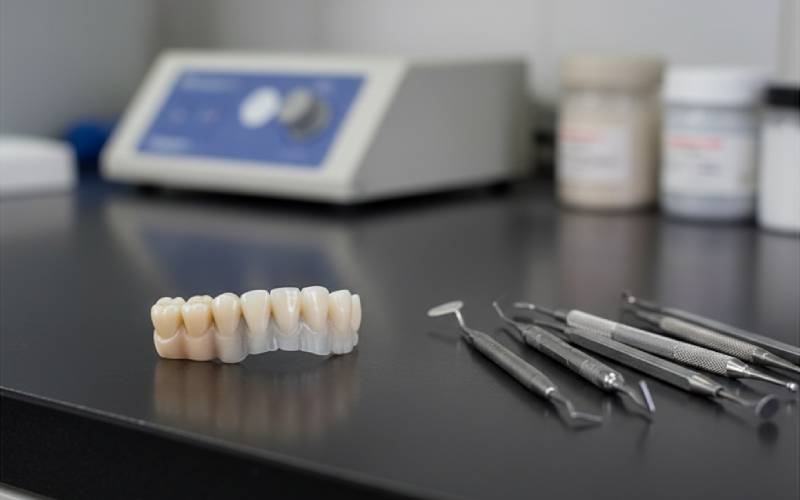
Dental Implant vs. Dental Bridge: The Best Way to Replace Missing Teeth
Losing a tooth can be a big problem. It changes the way you smile. It also changes how you chew your food and how you feel about yourself. When you have missing teeth, you want the best way to fix it. The two most usual choices are a implante dental or a dental bridge. But which one is the right one for you? This article will show you, in a simple and clear way, the dental bridge vs implant choice. We will tell you all the important things. You will learn about the cost, the steps to get one, and how long each one lasts. When you finish reading, you will feel ready to talk to your dentist about the right tooth replacement for your smile.
Índice
What Exactly Is a Dental Bridge for Missing Teeth?
A dental bridge does just what its name sounds like. It builds a bridge over the empty space from one or more missing teeth. Picture a real bridge that goes over a river. A dental bridge goes over the empty spot in your mouth. This way to fix your teeth is made of two key parts. The first part is the false teeth, which are called pontics. They sit in the empty space. The second part is what holds it up. A traditional bridge uses the natural teeth next to the empty space for support.
To make the bridge stay put, your dentist will put a dental crown on the two healthy teeth next to the gap. These teeth are called abutment teeth. The bridge uses these abutment teeth as anchors to hold it steady. This means the dentist has to change the shape of the neighboring teeth so the crowns can fit over them. There are other types of dental bridges, like a Maryland bridge. This kind uses metal or porcelain wings that are glued to the back of the adjacent teeth. A dental bridge is a common choice to replace a missing tooth because the bridge procedure is often quicker than getting a dental implant.
So, What Is a Dental Implant?
A dental implant is a totally different way to fix missing teeth. It does not depend on the surrounding teeth to hold it up. Instead, a dental implant works just like a new tooth root. Dental implants are titanium posts that have the shape of a screw. A surgeon places the dental implant right into your jawbone where the missing teeth were. This titanium post is very strong. Over a few months, it joins together with your bone. This makes a very solid spot for the new tooth.
After the dental implant has joined with your jawbone, your dentist puts on a small connector part called an abutment. Finally, a new crown that is made just for you is placed on top of the abutment. This crown is made to look and feel exactly like one of your natural teeth. A dental implant does not harm the teeth on either side of the space. This is a big difference when compared to dental bridges, which need to change healthy teeth. Getting a dental implant is a type of implant dentistry that is now done a lot.
Implant vs. Bridge: How Are the Dental Treatments Different?
The process of getting a dental implant is very different from getting a dental bridge. A dental bridge is a quicker job. It usually takes only two trips to the dentist. On the first trip, the dentist gets the abutment teeth ready by shaving down some of the outside of the tooth. Then, they will make a mold of your teeth to create the bridge. On the second trip, they check the fit and then glue the long-lasting dental bridge in place. You can be all finished in just a few weeks.
The implant vs bridge process is very different. A dental implant takes more time. Dental implants require a surgery to put the titanium post into your jaw. After the surgery, you must wait a few months. This lets the bone grow around the implant and make it strong. This healing time is really needed to support the implant. Once it is all healed, the dentist can put on the abutment and crown. The whole dental implant process can take from three to nine months. It takes more time from start to finish, but many people feel what you get in the end is worth waiting for.

Which Lasts Longer: Implants and Bridges?
When you pick a tooth replacement option, you want it to last a long time. This is a big way that dental implants and bridges are different. Dental implants can last for a very long time. With good dental care and regular dental check-ups, implants can last a lifetime. The titanium post is very strong and long-lasting. It joins with your jaw and stays there. The crown on top might need to be replaced after 10 to 15 years because of everyday use, but the implant itself is there for good.
Dental bridges don’t last as long. A dental bridge usually lasts between 5 and 15 years. How long a dental bridge lasts is all about the health of the abutment teeth that hold it up. Because these adjacent teeth have crowns on them, they can still get tooth decay or gum problems. Any problems with the neighboring teeth can mean the bridge may have to be replaced. So, a dental bridge is a good choice, but implants last longer.
What are the Pros and Cons of Dental Bridges?
Just like any other thing a dentist does, there are good and bad points. It is important to look at the pros and cons before making a choice. Here are the main points for a dental bridge.
Pros of a Dental Bridge:
- Quicker to Get: A dental bridge is usually finished in just two visits over a couple of weeks.
- Costs Less at the Start: Dental bridges are generally not as expensive at the beginning as a dental implant.
- You Don’t Need Surgery: The process does not need surgery on your jawbone, which some people like better.
- Se ve bien: A dental bridge that is made well looks natural. It also fixes your smile and helps you chew.
Cons of Dental Bridges:
- Harms Healthy Teeth: The biggest downside is that it means changing the shape of healthy teeth next to the gap to support a bridge.
- Tougher to Keep Clean: It can be hard to floss beneath a bridge. This can cause gum problems or tooth decay in the abutment teeth.
- Doesn’t Last as Long: Dental bridges typically have to be replaced more often than a dental implant.
- Jawbone Can Get Weaker: The jawbone under the missing one tooth isn’t being used, so it can get smaller over time.
And What are the Pros and Cons of Dental Implants?
Now, let’s look at the pros and cons of dental implants. A dental implant is often called the best choice for replacing missing teeth by the American Dental Association. But it is not the perfect choice for every person.
Pros of a Dental Implant:
- Keeps Other Teeth Safe: A dental implant doesn’t use the surrounding teeth for help. This leaves your healthy teeth alone.
- Lasts a Very Long Time: Dental implants can last a lifetime with good care. This makes them a fix that is meant to last forever.
- Stops Bone Loss: The dental implant works like a real tooth root. This keeps the jawbone busy and strong.
- Looks and Feels Like a Real Tooth: Implants offer a very solid tooth replacement that feels natural.
Cons of Dental Implants:
- Takes More Time: The dental implant process takes many months to finish.
- You Need to Have Surgery: The implant requires a surgery. This can have problems like getting sore or infected, or implant failure.
- Costs More Up Front: The initial cost of dental implants is usually more than the cost for a dental bridge.
- You Must Have a Strong Jawbone: Not everyone can get one. You need to have enough healthy jawbone to support the dental implant.
Can a Dental Bridge or Implant Replace More Than One Missing Tooth?
Yes, both dental implants and dental bridges can be used to replace one or several missing teeth. A traditional dental bridge can fill a space of one, two, or even three missing teeth in a row. This works as long as there are strong natural teeth or dental implants on each side that are strong enough to support a bridge. The bigger the bridge, the more pressure it puts on the abutment teeth.
Dental implants can also be used in many ways. To replace one or more missing teeth, you could get a separate dental implant for each tooth that is gone. Another good choice is implant-supported bridges. For this, two dental implants can be put in to hold up a bridge that fills a space of three or four missing teeth. This gives you the strength of implants and bridges the space without needing an implant for every tooth. This is a good choice when you are missing a few teeth in a row.
How Does the Cost of Implants Compare to a Dental Bridge?
Cost is a very important thing for most people to think about. When comparing dental bridges and implants, you should look at what it costs now and what it will cost later on. The dental bridges cost at the start is usually lower than the cost of implants. This makes a dental bridge seem like the less expensive choice at first. Your dental insurance might also pay for more of the cost of a bridge than a dental implant.
But, dental implants tend to be a better deal in the long run. The cost of dental implants is generally higher at the beginning, but they last much longer. A dental bridge might have to be replaced every 10 years or so. The cost of replacing a bridge two or three times could be more than the cost of just one dental implant. When you think about the bridge versus implant cost, think about the full cost over 20 or 30 years.
Bridge or Implant: Which Tooth Replacement is Right for You?
So, how do you pick between implants or bridges? The best pick is based on your health, how much you can spend, and what you like best. The people who are a good fit for dental implants are healthy in general and have a strong jawbone. If your jawbone is not strong enough, you might need another procedure to build it up before getting a dental implant. If you want the fix that lasts forever and keeps your other teeth safe, a dental implant is often the better pick.
A dental bridge instead could be better if you want a quicker fix. It might also be better if you have health problems that could make surgery unsafe. If the adjacent teeth already have big fillings or caps on them, using them as abutment teeth for a dental bridge is a very smart idea. The chart below helps to sum up the dental bridge vs implant choice.
| Característica | Puente dental | Implantes dentales |
|---|---|---|
| Cuánto dura | 5-15 años | 25+ years, often for life |
| What It Does to Other Teeth | Must file down healthy teeth | Leaves other teeth alone |
| Cuánto se tarda | 2-3 semanas | 3-9 months |
| Surgery Required? | No | Sí |
| Cost at the Start | Baja | Más alto |
| Salud Jawbone | Jawbone can get weak under the gap | Keeps the jawbone strong |

How Do I Care for My New Dental Implants and Bridges?
Good dental care is the most important part of making your dental implants and dental bridges last. For a dental implant, taking care of it is easy. You brush it and floss it just like your natural teeth. You do not need any special tools. Keeping the gums healthy around the implant is the biggest job.
Taking care of a dental bridge is a bit harder. You still have to brush the crowns and the artificial teeth. But, you also have to clean the space beneath a bridge that is between the false tooth and your gums. You will need to use a special kind of floss or a tiny brush to clean under there. This stops sticky germs from building up, which can cause trouble for the abutment teeth. It does not matter which one you get, because regular dental check-ups are very important.
Aspectos clave
When you need to replace missing teeth, both a dental bridge and a dental implant are great choices. Your pick will be based on what you need. Here are the most important things to know from our dental bridge vs implant talk:
- Soporte: A dental bridge is held up by the neighboring teeth. A dental implant is held in place right in your jawbone.
- Cuánto duran: Dental implants offer a fix that lasts a lot longer. They can last for life, while bridges often need to be replaced.
- Tooth Health: A dental implant keeps your healthy teeth safe. A dental bridge needs you to change the teeth next to the empty space.
- Coste: A dental bridge costs less at the start. But a dental implant can save you money over many years.
- Process: The bridge procedure is much quicker. Getting a dental implant takes longer and needs surgery.
- Hable con su dentista: The very best way to decide is to talk with your dentist. They can look at the health of your mouth and help you pick the tooth replacement option that will help you get a great smile that is also healthy.




